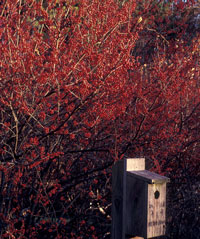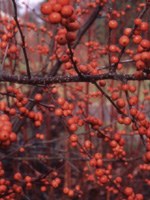Winterberry (Ilex verticillata)
 |
Native Winterberry is an increasingly popular Holly. Also called Black Alder or Michigan Holly, Winterberry grows wild in swamps and wet woods of the East and is extremely cold hardy. Unlike that of familiar traditional Hollies its foliage lacks spines and it is deciduous, dropping in the fall. Breeders have combined it with its Asian cousin Ilex serrata to develop hybrids. Like all Hollies Winterberry is easy to grow and bears colorful berries beloved of birds.
While shrub Hollies like Winterberry will grow as tall as 20 feet, typically they are closer to 9 feet tall. Their maximum spread may reach 13 feet if they are not pruned. Most grow by underground stems, developing into thickets of thin stems unless judiciously pruned. Growing in clumps, they have a dense oval rounded shape.
 |
Winterberry leaves are not like typical Holly leaves. They are deciduous, turning black and dropping off after their fall show of color and the first hard winter freeze. They are oval and 1 to 1-1/2 inches long, even larger on new growth. They are up to 1/2 inch wide. They have finely-toothed edges and downy undersides. Purplish green, especially in the spring, they are a translucent fresh green during the season. Many turn yellow in the autumn.
Winterberry flowers are creamy-white and very inconspicuous. Flowers on male plants grow in small clusters of 18 to 25 where leaf stems join the main stems, whereas those on female plants are in smaller clusters of 1 to 3. Flowers of both sexes appear in late spring or early summer. Shrubs of each sex must be planted near each other to assure pollination and a crop of berries. The attractive bright red berries, about 1/4 inch in diameter, appear in late August or September on the female shrub. They appear in clusters close to the stem as the leaves fall and persist into January if the birds do not get them first. Some Winterberry varieties bear orange or yellow berries. Plants will be 6 to 8 years old before maximum fruiting.
 |
‘Winter Gold’ is 2005 Gold Medal Plant Winner
‘Winter Gold’ is a branch sport of Ilex verticillata Winter Red®. It has jazzy orange-yellow berries from September through December. This native tolerates nearly all situations but does best in the boggy shrub border. Use a male pollinator such as ‘Southern Gentleman’ or ‘Apollo’. Grows 7'H x 7'W, in full or part-shade and moist, well-drained acidic soils. Hardy in zones 4 to 8. It was selected by the Pennsylvania Horticultural Society as one of its 2005 Gold Medal Plant Winners, a very prestigious award. For more information and some sources go to The Gold Medal Web Site
Other Choices of Winterberry
Cultivars of Winterberry will vary in size and color of fruit.
’Afterglow' is 5 to 6 feet tall and has orange-red berries;
‘Aurantiaca’ grows to 4 or 5 feet and has yellow-orange berries;
‘Cacapon’ grows to 6 1/2 feet tall with glossy, deep red fruits;
’Red Sprite’ [Nana] reaches only 4 feet but has large, abundant berries;
’Red Shaver' grows to 5 1/2 feet with large, long lasting orange-red berries;
x `Sparkleberry' [hybrid] is a multi-stemmed shrub with large bright red fruit. It grows to 12 feet in 15 years.

